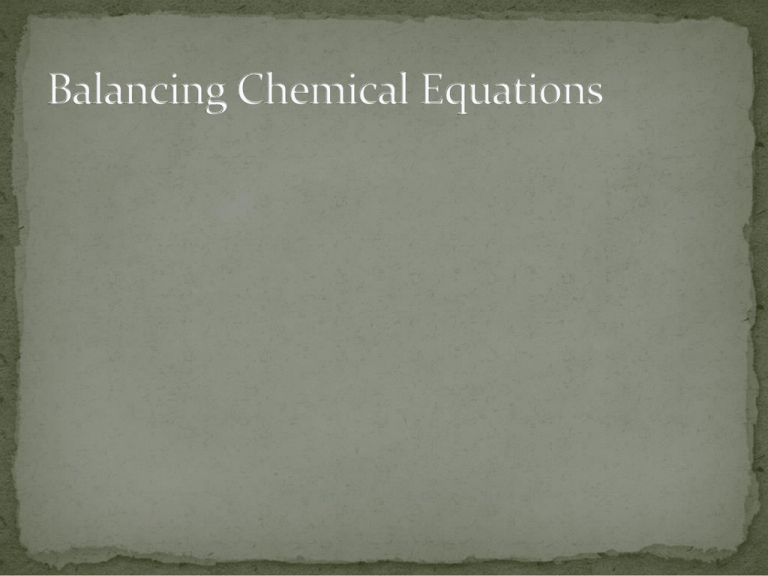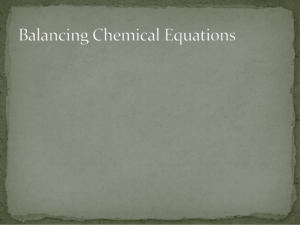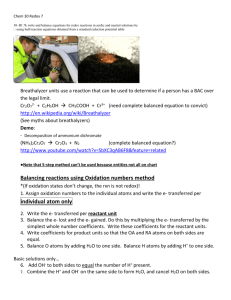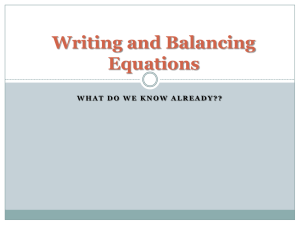Balancing Chemical Equations
advertisement

Chemical equation - Describes a chemical change. Parts of an equation: Reactant Product 2Ag + H2S Ag2S + H2 Reaction symbol Reactant - The chemical(s) you start with before the reaction. Written on left side of equation. Product - The new chemical(s) formed by the reaction. Right side of equation. Subscript - shows how many atoms of an element are in a molecule. EX: H2O 2 atoms of hydrogen (H) 1 atom of oxygen (O) Coefficient - shows how many molecules there are of a particular chemical. EX: 3 H2O Means there are 3 water molecules. 2H2 + O2 2H2O In a chem. rxn, matter is neither created nor destroyed. In other words, the number and type of atoms going INTO a rxn must be the same as the number and type of atoms coming OUT. If an equation obeys the Law of Conservation, it is balanced. CH4 + O2 CO2 + H2O Reactant Side 1 carbon atom 4 hydrogen atoms 2 oxygen atoms Product Side 1 carbon atom 2 hydrogen atoms 3 oxygen atoms A Balanced Equation CH4 + 2O2 CO2 + 2H2O Reactant Side 1 carbon atom 4 hydrogen atoms 4 oxygen atoms Product Side 1 carbon atom 4 hydrogen atoms 4 oxygen atoms 1. Matter cannot be created or destroyed. 2. Subscripts cannot be added, removed, or changed. 3. You can only change coefficients. 4. Coefficients can only go in front of chem. formulas...NEVER in the middle of a formula. A few extra tips: Try balancing big formulas first; save free elements for last. If the same polyatomic ion appears on both sides of the equation, it’s usually okay to treat it as one unit. There is no one particular way to balance equations. Some equations are harder to balance than others and might require some creativity to solve. Balance the following equation by adjusting coefficients. N2 + 3 H2 2NH3 reactants products N 2 21 H 6 2 63 Balance the following equation by adjusting coefficients. 2 KClO3 2 KCl + 3 O2 reactants products K 1 2 12 Cl 1 2 1 2 O 3 6 2 6 Balance the following equation: 2 C2H6 + 7 O2 4 CO2 + 6H2O Balance the following equation: 4 Fe +3 O2 2 Fe2O3 ____ N2 + ____ H2 ____ NH3 ____ NaF + ____ Br2 ____ NaBr + ____ F2 ____ Pb(OH)2 + ____ HCl ____ H2O + ____ PbCl2 ____ AlBr3 + ____ K2SO4 ____ KBr + ____ Al2(SO4)3 ____ CH4 + ____ O2 ____ CO2 + ____ H2O ____ Na3PO4 + ____ CaCl2 ____ NaCl + ____ Ca3(PO4)2 ____ K + ____ Cl2 ____ KCl ____ Al + ____ HCl ____ H2 + ____ AlCl3






